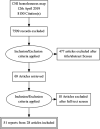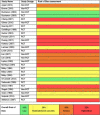Accommodation-based interventions for individuals experiencing, or at risk of experiencing, homelessness
- PMID: 37131929
- PMCID: PMC8356295
- DOI: 10.1002/cl2.1165
Accommodation-based interventions for individuals experiencing, or at risk of experiencing, homelessness
Update in
-
PROTOCOL: Accommodation-based interventions for individuals experiencing, or at risk of experiencing, homelessness.Campbell Syst Rev. 2020 Sep 8;16(3):e1103. doi: 10.1002/cl2.1103. eCollection 2020 Sep. Campbell Syst Rev. 2020. PMID: 37133280 Free PMC article. No abstract available.
Abstract
Background: Globally, almost 1.6 billion individuals lack adequate housing. Many accommodation-based approaches have evolved across the globe to incorporate additional support and services beyond delivery of housing.
Objectives: This review examines the effectiveness of accommodation-based approaches on outcomes including housing stability, health, employment, crime, wellbeing, and cost for individuals experiencing or at risk of experiencing homelessness.
Search methods: The systematic review is based on evidence already identified in two existing EGMs commissioned by the Centre for Homelessness Impact (CHI) and built by White et al. The maps were constructed using a comprehensive three stage search and mapping process. Stage one mapped included studies in an existing systematic review on homelessness, stage two was an extensive search of 17 academic databases, three EGM databases, and eight systematic review databases. Finally stage three included web searches for grey literature, scanning reference lists of included studies and consultation with experts to identify additional literature. We identified 223 unique studies across 551 articles from the effectiveness map on 12th April 2019.
Selection criteria: We include research on all individuals currently experiencing, or at risk of experiencing homelessness irrespective of age or gender, in high-income countries. The Network Meta-Analysis (NMA) contains all study designs where a comparison group was used. This includes randomised controlled trials (RCTs), quasi-experimental designs, matched comparisons and other study designs that attempt to isolate the impact of the intervention on homelessness. The NMA primarily addresses how interventions can reduce homelessness and increase housing stability for those individuals experiencing, or at risk of experiencing, homelessness. Additional outcomes are examined and narratively described. These include: access to mainstream healthcare; crime and justice; employment and income; capabilities and wellbeing; and cost of intervention. These outcomes reflect the domains used in the EGM, with the addition of cost.
Data collection and analysis: Due to the diverse nature of the literature on accommodation-based approaches, the way in which the approaches are implemented in practice, and the disordered descriptions of the categories, the review team created a novel typology to allow meaningful categorisations for functional and useful comparison between the various intervention types. Once these eligible categories were identified, we undertook dual data extraction, where two authors completed data extraction and risk of bias (ROB) assessments independently for each study. NMA was conducted across outcomes related to housing stability and health.Qualitative data from process evaluations is included using a "Best Fit" Framework synthesis. The purpose of this synthesis is to complement the quantitative evidence and provide a better understanding of what factors influenced programme effectiveness. All included Qualitative data followed the initial framework provided by the five main analytical categories of factors of influence (reflected in the EGM), namely: contextual factors, policy makers/funders, programme administrators/managers/implementing agencies, staff/case workers and recipients of the programme.
Main results: There was a total of 13,128 people included in the review, across 51 reports of 28 studies. Most of the included studies were carried out in the United States of America (25/28), with other locations including Canada and the UK. Sixteen studies were RCTs (57%) and 12 were nonrandomised (quasi-experimental) designs (43%). Assessment of methodological quality and potential for bias was conducted using the second version of the Cochrane Risk of Bias tool for Randomised controlled trials. Nonrandomised studies were coded using the ROBINS- I tool. Out of the 28 studies, three had sufficiently low ROB (11%), 11 (39%) had moderate ROB, and five (18%) presented serious problems with ROB, and nine (32%) demonstrated high, critical problems with their methodology. A NMA on housing stability outcomes demonstrates that interventions offering the highest levels of support alongside unconditional accommodation (High/Unconditional) were more effective in improving housing stability compared to basic support alongside unconditional housing (Basic/Unconditional) (ES=1.10, 95% confidence interval [CI] [0.39, 1.82]), and in comparison to a no-intervention control group (ES=0.62, 95% CI [0.19, 1.06]). A second NMA on health outcomes demonstrates that interventions categorised as offering Moderate/Conditional (ES= 0.36, 95% CI [0.03, 0.69]) and High/Unconditional (ES = 0.22, 95% CI [0.01, 0.43]) support were effective in improving health outcomes compared to no intervention. These effects were smaller than those observed for housing stability. The quality of the evidence was relatively low but varied across the 28 included studies. Depending on the context, finding accommodation for those who need it can be hindered by supply and affordability in the market. The social welfare approach in each jurisdiction can impact heavily on support available and can influence some of the prejudice and stigma surrounding homelessness. The evaluations emphasised the need for collaboration and a shared commitment between policymakers, funders and practitioners which creates community and buy in across sectors and agencies. However, co-ordinating this is difficult and requires sustainability to work. For those implementing programmes, it was important to invest time in developing a culture together to build trust and solid relationships. Additionally, identifying sufficient resources and appropriate referral routes allows for better implementation planning. Involving staff and case workers in creating processes helps drive enthusiasm and energy for the service. Time should be allocated for staff to develop key skills and communicate engage effectively with service users. Finally, staff need time to develop trust and relationships with service users; this goes hand in hand with providing information that is up to date and useful as well making themselves accessible in terms of location and time.
Authors' conclusions: The network meta-analysis suggests that all types of accommodation which provided support are more effective than no intervention or Basic/Unconditional accommodation in terms of housing stability and health. The qualitative evidence synthesis raised a primary issue in relation to context: which was the lack of stable, affordable accommodation and the variability in the rental market, such that actually sourcing accommodation to provide for individuals who are homeless is extremely challenging. Collaboration between stakeholders and practitioners can be fruitful but difficult to coordinate across different agencies and organisations.
© 2021 The Authors. Campbell Systematic Reviews published by John Wiley & Sons Ltd on behalf of The Campbell Collaboration.
Figures










Similar articles
-
Impact of summer programmes on the outcomes of disadvantaged or 'at risk' young people: A systematic review.Campbell Syst Rev. 2024 Jun 13;20(2):e1406. doi: 10.1002/cl2.1406. eCollection 2024 Jun. Campbell Syst Rev. 2024. PMID: 38873396 Free PMC article. Review.
-
Exploring the effect of case management in homelessness per components: A systematic review of effectiveness and implementation, with meta-analysis and thematic synthesis.Campbell Syst Rev. 2023 May 17;19(2):e1329. doi: 10.1002/cl2.1329. eCollection 2023 Jun. Campbell Syst Rev. 2023. PMID: 37206622 Free PMC article. Review.
-
A comprehensive review of prioritised interventions to improve the health and wellbeing of persons with lived experience of homelessness.Campbell Syst Rev. 2021 Jun 24;17(2):e1154. doi: 10.1002/cl2.1154. eCollection 2021 Jun. Campbell Syst Rev. 2021. Update in: Campbell Syst Rev. 2019 Sep 12;15(3):e1048. doi: 10.1002/cl2.1048. PMID: 37131928 Free PMC article. Updated. Review.
-
The future of Cochrane Neonatal.Early Hum Dev. 2020 Nov;150:105191. doi: 10.1016/j.earlhumdev.2020.105191. Epub 2020 Sep 12. Early Hum Dev. 2020. PMID: 33036834
-
Interventions that address institutional child maltreatment: An evidence and gap map.Campbell Syst Rev. 2021 Mar 9;17(1):e1139. doi: 10.1002/cl2.1139. eCollection 2021 Mar. Campbell Syst Rev. 2021. PMID: 37133265 Free PMC article.
Cited by
-
Research-What is it good for? Absolutely nothing… unless it is used to inform policy and practice.Campbell Syst Rev. 2022 Sep 13;18(3):e1276. doi: 10.1002/cl2.1276. eCollection 2022 Sep. Campbell Syst Rev. 2022. PMID: 36909876 Free PMC article. No abstract available.
-
Campbell Collaboration: Reflection on growth and cultivation from 2017 to 2021.Campbell Syst Rev. 2021 Dec 17;17(4):e1204. doi: 10.1002/cl2.1204. eCollection 2021 Dec. Campbell Syst Rev. 2021. PMID: 36950340 Free PMC article. No abstract available.
-
A non-randomised controlled trial of a community-based accommodation and psychosocial support programme for adults experiencing mental illness and homelessness.Aust N Z J Psychiatry. 2024 Dec;58(12):1070-1079. doi: 10.1177/00048674241270996. Epub 2024 Aug 16. Aust N Z J Psychiatry. 2024. PMID: 39152551 Free PMC article. Clinical Trial.
-
Accessible independent housing for people with disabilities: A scoping review of promising practices, policies and interventions.PLoS One. 2024 Jan 25;19(1):e0291228. doi: 10.1371/journal.pone.0291228. eCollection 2024. PLoS One. 2024. PMID: 38271462 Free PMC article.
-
Supporting Stabilization: A Qualitative Evaluation of a Pilot Program to Integrate Personal Caregiving Services Into Housing Settings.Inquiry. 2024 Jan-Dec;61:469580241248084. doi: 10.1177/00469580241248084. Inquiry. 2024. PMID: 38641977 Free PMC article.
References
REFERENCES TO STUDIES
INCLUDED STUDIES
-
- Appel, P. W. , Tsemberis, S. , Joseph, H. , Stefancic, A. , & Lambert‐Wacey, D. (2012). Housing first for severely mentally ill homeless methadone patients. Journal of Addictive Diseases, 31(3), 270–277. - PubMed
-
- Aquin, J. P. , Roos, L. E. , Distasio, J. , Katz, L. Y. , Bourque, J. , Bolton, J. M. , Bolton, S. L. , Wong, J. Y. , Chateau, D. , Somers, J. M. , Enns, M. W. , Hwang, S. W. , Frankish, J. C. , Sareen, J. , & At Home/Chez Soi, I. (2017). Effect of housing first on suicidal behaviour: A randomised controlled trial of homeless adults with mental disorders. The Canadian Journal of Psychiatry, 62(7), 473–481. - PMC - PubMed
OTHER REFERENCES
-
- Bassuk, E. L. , DeCandia, C. J. , Tsertsvadze, A. , & Richard, M. K. (2014). The effectiveness of housing interventions and housing and service interventions on ending family homelessness: A systematic review. The American Journal of Orthopsychiatry, 84(5), 457–474. - PubMed
-
- Baxter, A. J. , Tweed, E. J. , Katikireddi, S. V. , & Thomson, H. (2019). Effects of Housing First approaches on health and well‐being of adults who are homeless or at risk of homelessness: Systematic review and meta‐analysis of randomised controlled trials. Journal of Epidemiology and Community Health, 73(5), 379–387. - PMC - PubMed
-
- Beaudoin, I. (2016). Efficacité de l'approche logement d'abord: une revue systématique. Drogues, santé et société, 14(2), 43–69.
Publication types
LinkOut - more resources
Full Text Sources
Miscellaneous
